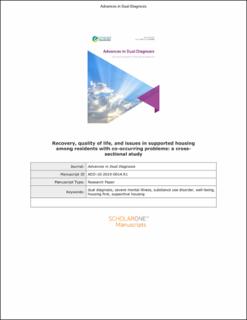| dc.description.abstract | Recovery for residents who experience co-occurring problems and live in supported housing takes place in everyday contexts. This study aims to explore residents’ self-reported recovery and quality of life and examine the relationships between these factors and issues in supported housing. Design/methodology/approach A cross-sectional study was conducted at 21 supported housing sites in six cities across Norway. A total of 104 residents (76 men and 28 women) responded to measures of recovery (Recovery Assessment Scale – Revised), life satisfaction (Manchester Short Assessment of Quality of Life), affect (single items), staff support (Brief INSPIRE) and sense of home (single items). Findings Linear regression analyses indicated associations between recovery and staff support (B = 0.01, 95% CI = 0.01-0.02, ß = 0.39), housing satisfaction (B = 0.15, 95% CI = 0.07-0.22, ß = 0.38), sense of home (B = 0.23, 95% CI = 0.14-0.32, ß = 0.49) and satisfaction with personal economy (B = 0.11, 95% CI = 0.05-0.17, ß = 0.33). Similarly, associations were found between life satisfaction and staff support (B = 0.03, 95% CI = 0.02-0.04, ß = 0.46), housing satisfaction (B = 0.63, 95% CI = 0.46-0.80, ß = 0.60), sense of home (B = 0.65, 95% CI = 0.42-0.87, ß = 0.51) and satisfaction with personal economy (B = 0.34, 95% CI = 0.19-0.50, ß = 0.39). Originality/value The findings imply that core issues in supported housing, namely, staff support, housing satisfaction, sense of home and satisfaction with personal economy, are associated with recovery and quality of life | |
